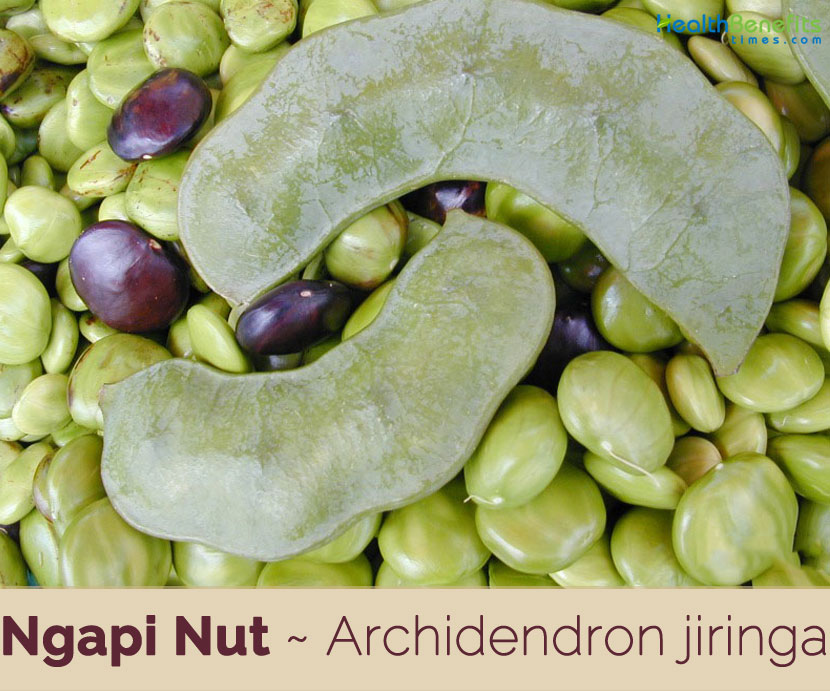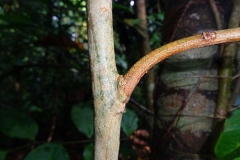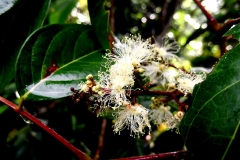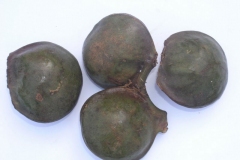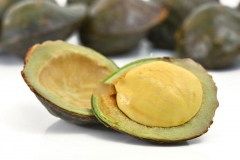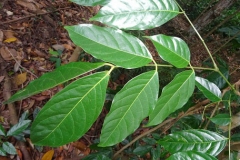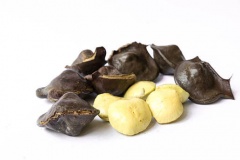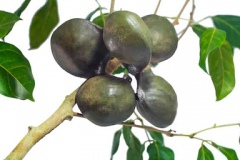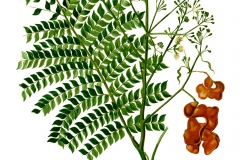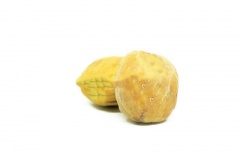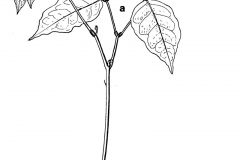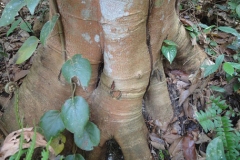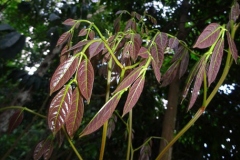Plant Description
Ngapi Nut is a medium-sized legume tree that grows up to 21 m tall and 60 cm of trunk diameter with grey smooth bark, white wood, terete and with smooth branchlets. The plant is found growing in forests of humid and mountainous areas, along river banks, primary and secondary rain forest, evergreen forest, high rainfall, mountainous areas, undulating hills, lowland flats and along river banks. The plant prefers a well-drained soil. It is found growing on sandy soils, lateritic soils and reddish sandy clay on flat land and low undulating hills. Bark is grey or grey-white, usually smooth, rarely flaky, inner bark is pink or reddish brown. Sapwood is white or pinkish white, heartwood white, with a strong smell of garlic.
Leaves
The leaves are 2-pinnate and measures up to 25 cm long. The petiole is measures 2-6 cm long. The leaflets are 2-3 pairs per pinna, ovate-elliptical to oblong, measuring about 8-15 cm long and 4-5 cm wide, opposite, chartaceous, hairless. The young leaves have a wine-red color and are edible.
Flowers
The inflorescence is an axillary, paniculate and measures up to 20 cm long. The flowers are sessile, 4-7 together in a pseudo-umbel on a short peduncle, 5-merous and bisexual. The sepal is a cup-shaped. The petal is tubular, measuring 4-5 mm long, with 5-lobed and white. The stamens are numerous where at the base they are united into a tube and with free filament parts that are about 5 mm long. Flowering time of the tree is between September and January.
Fruit
The fruit (legume) of the tree is a woody, glabrous and deep purple pod. Each Pod contains around three to nine round-shaped seeds. The pods are formed semicircular or twisted in a wide spiral. The seed coat of a young seed shows a yellow-green color and turns into dark brown during ripening. Then the ripe fruit dehisces along the ventral suture. The seeds are orbicular compressed, measuring about 35 mm long and 10 mm wide, yellow-green testa when young and turn dark brown as they mature. The germination is hypogeal and the first five leaves are scale-shaped.
Health benefits of Ngapi Nut
Listed below are some of the popular health benefits of Ngapi nuts
1. Prevent Anemia
Ngapi Nut is rich in iron in which is very contributory to prevent and overcome the lack of production of red blood cells in the body. You certainly know that when the body lacks iron, the production of red blood cells will decrease. As a result the supply of oxygen and nutrients needed by all cells in the body will also be reduced.
The effects of a lack of oxygen supply and nutrients in the cells will decrease cell function / performance. No wonder if a person has iron deficiency, he will look weak, tired, and not excited. Consuming Ngapi Nut during menstruation is strongly recommended since your body lack iron due to the large amount of menstrual blood that comes out of the body.
2. Prevents Bone Loss / Strengthens bones and teeth
Apart from iron and protein, Ngapi Nut consists of good amount of calcium and phosphorus. These two substances are quite essential for your bones. Calcium and phosphorus can prevent bone loss (osteoporosis). So, often consume Ngapi Nut with a portion sufficient to make the bones become stronger.
3. Eliminate Free Radicals
Ngapi Nut consists of some vitamins such as vitamin A, vitamin B1, vitamin B2, and vitamin C. Vitamin A is beneficial for maintaining eye health and can improve the sharpness of the sense of sight. Vitamin A and Vitamin C also acts as an antioxidant. The benefits of antioxidants are known potent substances that counteract free radicals cause cancer.
4. Managing coronary heart disease
Bigfoot is a food that is a diuretic (urine disposal to be smooth). Smooth disposal of urine is very good for people with heart disease.
5. Troubleshooting constriction of blood vessels
Patients with heart disease experienced a narrowing of blood vessels so that blood flowing toward the heart becomes smooth. The mineral content in Ngapi Nut can dilate narrowed blood vessels and prevent blood vessel narrowing back. Well, for optimal efficacy, you should not cook Ngapi Nut too much (overcooked).
6. Stabilize the vital organs in the body
Essential organs in the body will function properly and stable if the body fulfilled the needs of folic acid and vitamin B6. Pregnant women are also advised to consume foods rich in folic acid for the development of the fetus.
Ngapi Nut is one of the best examples of foods rich in folic acid. But once it should be remembered that consume Ngapi Nut sufficiently. Do not consume excessively because excessive Ngapi Nut will be less good effect for kidney organs.
7. Maintain heart health
As mentioned above, Ngapi Nut consists of antioxidant substances that are very good for the health of the body especially heart health. Toxins or toxins in the body will be difficult to enter the body, especially the heart, thanks to the protection provided by these antioxidants. Anything that blocks the flow of blood in the blood vessels will also be lost by the substances contained in Ngapi Nut. Blood flow will become smoother and the heart will function properly and optimally.
8. Streamline the stomach
Ngapi Nut can help streamline a swollen stomach. High fiber content can launch defecate so indirectly makes the stomach slim. One of the causes of distended stomach in a person is due to defecation that is not smooth and irregular.
Traditional uses and benefits of Ngapi Nut
- Seeds are believed to relieve diabetes symptoms.
- Burnt old leaves can be used against itching while burnt young leaves can be used as wound powder for cuts.
- They are also applied traditionally as a diuretic, but are poisonous when eaten in large amounts.
- Raw seeds are thought to purify the blood or cure dysentery.
- Compresses with young leaves are used for skin problems.
- The bark is used to treat toothache and pectoralgia.
- Leaves are applied externally to cuts and scabies.
- It is used to treat toothache, gum pains, chest pains and skin ailments in the old Malaysian folk.
- Leaves are used to help reduce symptoms of chest pain, toothaches, and skin problems.
- Leaves can also be ground into a powder and used to help heal cuts and wounds.
- In Malaysia, Ngapi Nut leaves have been used as a poultice for skin complaints and for pains in the chest in traditional medicine.
- Bark has been used for chest pains and to make a gargle for tooth-ache.
Culinary Uses
- Young leaves are cooked and the very young shoots and flowers are eaten as vegetables.
- Seeds are consumed raw or cooked.
- Young seeds are believed to have a better flavor than older ones, though some people prefer to eat germinating mature seeds.
- Seeds are boiled thoroughly till the offensive smell has disappeared, then consumed with salt and grated coconut.
- Very young wine-red shoots are consumed raw as a vegetable.
- Flowers are eaten as a vegetable.
- Seeds are used to flavor food and are enjoyed in Thailand, Indonesia and Malaysia.
- Immature seeds are eaten raw as ulam.
- Germinated seeds are eaten after removal of the sprouts.
- Wine-red, tender leaves and shoots are also consumed raw as ulam or vegetable.
- Seeds are also pounded with ginger and boiled before consumption.
- Seeds are also eaten with sambel kimiri (a paste made of pounded roasted candlenut, green chilies and dried shrimps) in Java.
- In southern Thailand, luk-nieng is always eaten with curry or with any hot food.
- Maturing seeds are boiled and the extracts are discarded several times.
- Mixture of fresh coconut endosperm and sugar is added to the cooked luk-nieng for consumption.
- Cooked luk-nieng in a solution of coconut milk and sugar is also popular in southern Thailand.
Other facts
- Ngapi Nut is a great source of purple dye for silk, black dye, and reddish dye.
- Pods are used as a shampoo.
- Bark, leaves, and seeds have insecticidal properties.
- Wood is soft and used for cabinet work and for fuel.
- Pods have been used as a source of purple dye for silk.
- Bark and leaves are used for dyeing matting black.
- Reddish dye is obtained from the seeds.
- Pulverized seeds are used, they are rich in saponins.
- Wood has a strong smell of garlic when fresh; it is soft, easy to saw and to work with.
- It is considered to be only suitable for cabinet work, interior joinery.
- The wood is used for fuel.
- The pods of the seeds dye silk purple and the bark of the tree dyes black.
- Shell is also being used for hair washing, timber as firewood and for building (e.g. coffins).
- Due to the content of djenkolic acids in the seeds, the raw seed is also being applied to the production of organic pesticides in combination with other plants to kill and prevent the growth of pests.
- Seed weight is approximately 15 g per seed.
- Wood is used for light construction, furniture, cabinet work, canoes.
- Ngapi Nut provides a purple dye on silk and has been used by dyers in Pekan, Pahang, Malaysia.
- In Borneo, the bark is used for dyeing matting black.
- The leaves can also be similarly used.
- Soft wood of the timber have been used for building coffins and as firewood.
Precautions
- Ingestion of the seed can cause the formation of sharp needle-like crystals of djenkolic acid in the kidney or urinary tract.
- In severe cases, crystals of djenkolic acid have been found in urine.
- Excessive consumption of Ngapi Nut can cause toxic effects to the heart, kidneys, liver and pancreas.
- Seed poisoning symptoms include muscle spasms, gout, urinary retention, and acute renal failure. The condition is mainly experienced by men.
- Eating Ngapi Nut in small amounts creates appearance problems, because it produces bad breath, sweat, feces, and urine. Actually this odor can be overcome by cleaning yourself with hygiene equipment containing fragrances, such as toothpaste, mouthwash, soap, and deodorant. Odor at the time of urination can be reduced if rinsing done before and after urine with sufficient amount of water or if necessary rinsed with cleaning fluid.
References:
https://pfaf.org/user/Plant.aspx?LatinName=Archidendron+jiringa
https://en.wikipedia.org/wiki/Archidendron_pauciflorum
https://www.itis.gov/servlet/SingleRpt/SingleRpt?search_topic=TSN&search_value=820806#null
http://www.theplantlist.org/tpl1.1/record/ild-32330
https://en.wikipedia.org/wiki/Talk%3AArchidendron_pauciflorum
https://uses.plantnet-project.org/en/Archidendron_jiringa_(PROSEA)
http://tropical.theferns.info/viewtropical.php?id=Archidendron+pauciflorum
http://www.theplantlist.org/tpl1.1/record/ild-46285
Comments
| Ngapi Nut Quick Facts | |
|---|---|
| Name: | Ngapi Nut |
| Scientific Name: | Archidendron jiringa or Archidendron pauciflorum |
| Origin | Southeast Asian countries and occurs wild and cultivated in Malaysia, Indonesia (Java, Sumatra, Kalimantan), Brunei, Thailand, Burma and Bangladesh |
| Colors | Yellow-green color when young and turns into dark brown during ripening |
| Shapes | Compressed, falcate, twisted, glabrous, woody legume, deep purple, deeply lobed along the lower suture, 20–25 cm long and 4–5 cm wide and easily broken by hand |
| Health benefits | Prevent Anemia, Prevents Bone Loss / Strengthens bones and teeth, Eliminate Free Radicals, Managing coronary heart disease, Troubleshooting constriction of blood vessels, Stabilize the vital organs in the body, Maintain heart health, Streamline the stomach |
| Name | Ngapi Nut |
|---|---|
| Scientific Name | Archidendron jiringa OR Archidendron pauciflorum |
| Native | Southeast Asian countries and occurs wild and cultivated in Malaysia, Indonesia (Java, Sumatra, Kalimantan), Brunei, Thailand, Burma and Bangladesh |
| Common Names | Blackbead, Dog Fruit, Djengkol Tree, Luk Nieng Tree, Ngapi Nut, Jing, Nieng, Niang, Kanieng, Chanieng, Yawng, Ngapi nut, Dhinyindi, Jering, Cha niang, Jaring, Tutung |
| Name in Other Languages | Burmese: Danyin-wek, tangyin, tanyeng-pen, Danyin, Dog Fruit, Taujin Cambodia: Krakos China: Bin lang English: Ngapi nut, Djengkol bean, djengkol tree, dog fruit French: Jengkol Indonesia: Jringkol, Jengkol, Jingkol, Jering, Jarring, Jaring-Jaring, Jengkol Hutan, Jering Altut, Tutung, Lubi, Jarung, jingkol, lubi, djengkol tree Malaysia: Jering, jiring Myanmar: Tangyin, tanyeng-pen, danyin, danyin-wek, dog fruit, tangyin, taujin, tanyeng-pen Nepali: Dhinyindi Malay: Jengkol, Jering, Jiring Swedish: Jengkol Thailand: Niang, niang-nok; chaniang; cha niang, khang deng, luk nieng, niang, pha niang, niang-yai |
| Plant Growth Habit | Medium-sized tree |
| Growing Climates | Forests of humid and mountainous areas, along river banks, Primary and secondary rain forest, evergreen forest, high rainfall and mountainous areas, undulating hills, lowland flats and along river banks |
| Soil | Prefers a well-drained soil. It is found growing on sandy soils, lateritic soils and reddish sandy clay on flat land and low undulating hills |
| Plant Size | Up to 21 m tall and 60 cm of trunk diameter |
| Bark | Grey or grey-white, usually smooth, rarely c. flaky, inner bark pink or reddish brown |
| Sapwood | White or pinkish white, heartwood white, with a strong smell of garlic |
| Leaf | Bipinnate and measures up to 25 cm long. The petiole is measures 2-6 cm long. The leaflets are 2-3 pairs per pinna, ovate-elliptical to oblong, measuring 8-15 cm x 4-5 cm, opposite, chartaceous, hairless and dark violet-red when young |
| Flowering season | Between September and January |
| Inflorescence | Inflorescence axillary, paniculate, 20 cm long with 4–7 sessile flowers in a pseudo-umbel |
| Flower | Pentamerous, bisexual, white with a cup shaped calyx and tubular corolla and numerous yellowish-white stamens |
| Fruit Shape & Size | Compressed, falcate, twisted, glabrous, woody legume, deep purple, deeply lobed along the lower suture, 20–25 cm by 4–5 cm wide and easily broken by hand. There are 3–6 seeds per pod. The seed is 3–5 cm across with yellow testa when young, which turns brown at maturity |
| Fruit Color | Yellow-green color when young and turns into dark brown during ripening |
| Seed | Compressed orbicular 2.5–3 cm across and 1.5 cm thick, with yellowish white testa |
| Propagation | By seed |
| Health Benefits |
|


